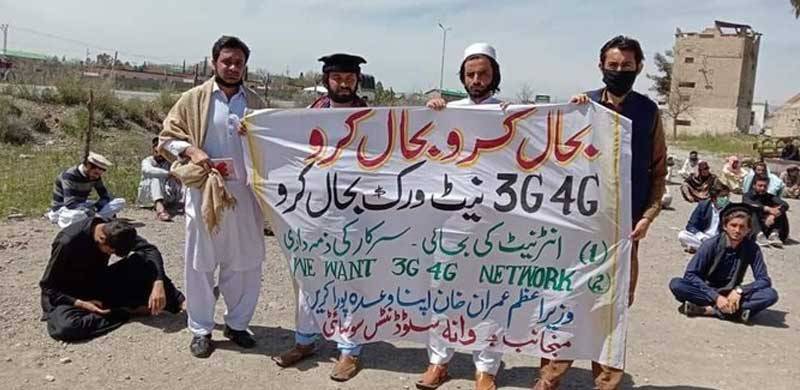
ISLAMABAD: Farman Dawar, a native of tribal districts, is worried about his future. For the past two months now, the BS student at the University of Wah has been living in a rented room in Bannu to attend his online classes. Dawar had returned to his town after the closure of his varsity, but he had to move to the city to access the internet.
“I was living in a hostel, but it has been closed since the lockdown. I had no option but to rent a room to ensure my online classes,” the engineering student told Naya Daur.
Dawar is among hundreds of other students belonging to the newly merged tribal districts and Gilgit-Baltistan, who can't access the internet in their hometowns and have to move to other urban areas to access the facility for their online classes.
“Despite various demonstrations, the internet remains inaccessible in our area, said South Waziristan resident Kashif Khan, who is also a PhD scholar at Quaid-e-Azam University, Islamabad.
Khan endorsed the distance learning in the wake of the coronavirus pandemic, he, however, urged the government to provide the internet to these remote areas to facilitate students.
“It is frustrating because the future of thousands of students is at stake,” he added.
Fahimullah Khan, another student from tribal districts, said that the students were facing many issues in attending the online classes due to persistent load-shedding and unavailability of the internet.
"In order to attend the classes regularly, you must have an alternate way to cope with power issues like solar plates and batteries," Fahimullah said. He said there were many areas where internet connection was not available and if there was a connection available, then it wouldn't be working properly.
A large number of GB students enrolled in various educational institutes across the country have staged various demonstrations against the online classes and poor internet connectivity in the northern region. According to the students, the internet facility by the Special Communication Organization in the area was poor. They also pointed out that remote areas of the region had no internet facility at all as the private phone companies were not allowed to provide 4G services.
Protest demonstrations were also held in Gilgit, Nagar, Astore, Diamer, Shigar and Ghizer.
According to the Global Economy 2017 survey, nearly 30 percent of the Pakistani population lives without electricity. Similarly, a survey conducted by Sri Lankan think-tank LIRNEasia stated that only 57 percent of Pakistanis had a mobile phone. Of them, only 22 percent had smartphones. The rest had cellphones with no internet connections.
“I was living in a hostel, but it has been closed since the lockdown. I had no option but to rent a room to ensure my online classes,” the engineering student told Naya Daur.
Dawar is among hundreds of other students belonging to the newly merged tribal districts and Gilgit-Baltistan, who can't access the internet in their hometowns and have to move to other urban areas to access the facility for their online classes.
“Despite various demonstrations, the internet remains inaccessible in our area, said South Waziristan resident Kashif Khan, who is also a PhD scholar at Quaid-e-Azam University, Islamabad.
Khan endorsed the distance learning in the wake of the coronavirus pandemic, he, however, urged the government to provide the internet to these remote areas to facilitate students.
“It is frustrating because the future of thousands of students is at stake,” he added.
Fahimullah Khan, another student from tribal districts, said that the students were facing many issues in attending the online classes due to persistent load-shedding and unavailability of the internet.
"In order to attend the classes regularly, you must have an alternate way to cope with power issues like solar plates and batteries," Fahimullah said. He said there were many areas where internet connection was not available and if there was a connection available, then it wouldn't be working properly.
A large number of GB students enrolled in various educational institutes across the country have staged various demonstrations against the online classes and poor internet connectivity in the northern region. According to the students, the internet facility by the Special Communication Organization in the area was poor. They also pointed out that remote areas of the region had no internet facility at all as the private phone companies were not allowed to provide 4G services.
Protest demonstrations were also held in Gilgit, Nagar, Astore, Diamer, Shigar and Ghizer.
According to the Global Economy 2017 survey, nearly 30 percent of the Pakistani population lives without electricity. Similarly, a survey conducted by Sri Lankan think-tank LIRNEasia stated that only 57 percent of Pakistanis had a mobile phone. Of them, only 22 percent had smartphones. The rest had cellphones with no internet connections.
